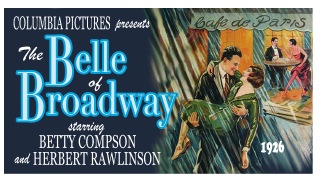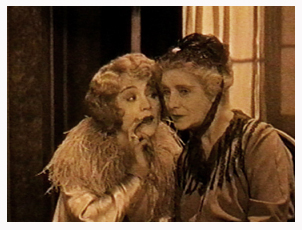

Directed by Harry O. Hoyt
Produced by Columbia Pictures Corporation
Premiere date: August 15, 1925
Based on the musical comedy "Adele, The Belle of Broadway"
Cast: Betty Compson (Marie Duval), Herbert Rawlinson (Paul Merlin),
Edith Yorke (Madame Adele), Armand Kaliz (Count Raoul de Parma),
Ervin Renard (Fabio Merlin), Thomas Ricketts (Maurice Penelli),
Wilfred North, Edward Warren, Edward Kipling, A. Tollaire
At the time of this writing, "Belle of Broadway"
is a recent release from the Sony Choice Collection and a pleasant
surprise since there was no formal announcement or fanfare regarding
its release. And although it's an obscure title, it has been newly
remastered and restored from an original tinted print, includes
an excellent original score composed by Christopher Caliendo,
and -  most
importantly -- holds the viewer's interest for a very enjoyable
60 minutes.
most
importantly -- holds the viewer's interest for a very enjoyable
60 minutes.
The story opens with a performance of "Du Barry" by Mme. Adele who is the toast of the Paris stage in 1896. Unfortunately, her husband, Fabio Merlin, is jealous of her many admirers, especially one persistent admirer -- Count Raoul de Parma -- in spite of the fact that Adele is completely faithful to her husband. However, after one particular performance, Fabio intercepts a note and flowers sent to her by the Count and, convinced she is receptive to the Count's overtures, leaves her, taking their baby with him. Thirty years later, no longer having the youth that audiences want, Adele still haunts the casting offices but gets no work. She has a young neighbor friend, Marie Duval, who just happens to run into Adele's son, Paul Merlin, on a rainy Paris street one night. Since Marie doesn't know Adele's real name, the name of Paul Merlin means nothing to her. However, he shares his umbrella with her and walks her home, obviously smitten with the girl he encountered in this chance meeting.
It must be noted here, too, that Paul, through Marie, does come in contact with his mother early on in the film, thinking her to be the housekeeper in the home of the grand Adele (that is, Marie posing as Adele -- we'll get to that in the next paragraph). Harrison's Reports called these scenes "suspensive," adding " . . . the spectator is made to hope that something will happen to let the mother that the young man before her is her son, and the young man that the elderly woman toward whom he had felt kindly the first time he saw her, is his mother." (1)
But we are getting ahead of ourselves. The story establishes its main premise one earlier evening in Mme. Adele's apartment. She tells Marie of the old days in the theatre and, reminiscing, decides to take out her old dress and wig from "Du Barry" for Marie to try on. The resemblance to the old Adele startles the elderly lady, and she calls her old manager, Penelli, over to see. Both agree that Marie could, if she has the ability, go on the stage as the "rejuvenated" Adele -- on the pretense that plastic surgery would explain the transformation from elderly to youthful. Marie does, indeed, successfuly revive "Du Barry" as the "rejuvenated" Adele, and audiences are once again in love with her, including several of her old beaus. One who returns is Count de Parma, who not only frustrates her romance with Paul, but also soon discovers that she is not the real Adele, further complicating matters. In the end, Paul happily learns Marie's real identity and that his mother is the real Adele.
 There is
much to recommend this film, not the least of which is Betty Compson
who is great in anything she does (don't miss her bravura performance
in "The Docks of New York" (1928)). Herbert Rawlinson,
who isn't always a standout in his films, is well-cast as Compson's
love interest in this film. The little known Armand Kaliz probably
gives the best performance, other than Compson, as the scheming
and arrogant Count.
There is
much to recommend this film, not the least of which is Betty Compson
who is great in anything she does (don't miss her bravura performance
in "The Docks of New York" (1928)). Herbert Rawlinson,
who isn't always a standout in his films, is well-cast as Compson's
love interest in this film. The little known Armand Kaliz probably
gives the best performance, other than Compson, as the scheming
and arrogant Count.
The other old beaus flit around the now youthful Adele (keep in mind this is Marie posing as the "rejuvenated" Adele), each wishing to marry her -- all very harmless and adding a bit of charm to the story. The Count, however, gives us our nemesis and carries it all out in a subtle but threatening way. Encountering Adele (Marie) and Paul at lunch one day, the Count is introduced to Paul. "I knew a Merlin years ago -- a -- Fabio Merlin," the Count says. "Why, he's my father," Paul exclaims. An intertitle then tells us, "The sudden realization that if this is really Madame Adele, she is unknowingly with her own son." The Count continues, "Strange that Madame does not remember the name of Merlin." Trying to keep up the pretense, Marie says, "But -- but I do remember. Fabio and I were very good friends." Knowing that Fabio was Adele's husband, the Count now knows that this is an imposter but leaves without revealing what he has learned.
When an invitation comes to Adele (Marie) to have dinner with Count de Parma at his apartment after the evening's performance, Penelli suggests she should go to deflect any suspicion. During dinner he makes Marie very uncomfortable talking of years past and his lovemaking with Adele -- which Marie, of course, cannot know whether it's true or not. She gets up from the table and tries to evade the topic, but, in her frustration mistakenly says, "I don't believe it -- Madame Adele could never -" "So -- I've made you admit it -- you're not Adele. But you're more desirable than she ever was," the Count tells her and then takes her in his arms.
As she is struggling with him, Paul forces himself into the apartment past the butler. Unfazed, the Count asks, "What is this woman to you?" to which Paul replies, "She is the woman I love and the woman I hope to marry!" When asked, Paul admits he does not know who Madame Adele is. "The real Adele was the wife of Fabio Merlin -- she is your -- mother!" the Count tells him. Not only is this a surprise for Paul, Marie learns this for the first time, as well. But the Count does not stop there. He adds, "And your mother's relations with me were very, very -" Before he can finish, Paul slaps the Count with his glove. "That's a damn lie!" Not surprisingly, the Count challenges Paul to a duel the next morning, and Paul accepts. Also not surprisingly, we learn that the Count is "the best shot in Paris."
Although not the most original of melodramas, this makes
a very engaging climax with all the necessary components of a
good story in the mix -- the innocent young girl, the dashing
young man who is in love with her, a bad guy we can enjoy disliking
-- all very well-defined characters with the sympathy aspect for
the older Adele thrown in for good measure. And we must mention
that the reunion of mother and son taps our emotions very deeply,
as well. Oh, sure it stretches the viewer's believability that
plastic surgery has brought about this sort of transformation,
but if we can't accept a little fantasy in our films, we would
be missing out on a lot of enjoyable stories. Harrison's Reports
did not feel this weak premise was a detriment  to the picture, "While this
is not believable, it has been done well enough to be accepted
by the picture-goer as fact." (2) Variety apparently
felt the rejuvenation angle was a positive. "Theme is one
of the stage and rejuvenation, in itself interesting." (3)
to the picture, "While this
is not believable, it has been done well enough to be accepted
by the picture-goer as fact." (2) Variety apparently
felt the rejuvenation angle was a positive. "Theme is one
of the stage and rejuvenation, in itself interesting." (3)
As noted, Betty Compson and Herbert Rawlinson make the film go over. "Miss Compson does good work. So does Mr. Herbert Rawlinson; he wins one's sympathy very easily," said one. (4) Edith Yorke, who was 59 at the time, does a superb job as the elderly Adele. "Edith Yorke is the former star, doing very well with it," one reviewer noted. (5)
"The Belle of Broadway" came during a period when Betty Compson was down on her luck and being considered a "has-been" by the Hollywood studios. Compson was a hard-working actress during her career, beginning, like so many, in two-reel comedies before getting her first big break in "The Miracle Man" (1918) which also made stars of Lon Chaney, Thomas Meighan, and Elinor Fair. Among her other standout films was "The Covered Wagon" (1923) directed by her future husband, James Cruze. Columbia was one of the poverty row studios in the twenties, and, when the major studios were not forthcoming with roles, Compson was not afraid to work in these low budget films noting that she made $180,000 one year acting for the poverty row studios. Of course, she soon got the attention of the big studios again, even earning an Oscar nomination for her performance in "The Barker" (1928), as well as getting great notices for films such as the aforementioned "The Docks of New York." Read more about this lovely actress in our Silents Are Golden article, "The Incomparable Compson."
Fortunately, "The Belle of Broadway" does not have the look of a low budget film. However, coming from a poverty row studio, it's not surprising that the reviews were not "gushing" -- but they were generally positive with Harrison's Reports noting that the feature was "Good" and added "While it is not a bad picture for the masses, it is suited chiefly for the better element." (6) Variety said, "Unusually fair picture for the independent market. Good enough to stand alone in the daily change houses in these days of double feature bill, and that is saying a whole lot." (7)
The restoration of "The Belle of Broadway" was
from an original tinted silent nitrate print, and the quality
is excellent. Christopher Caliendo's score includes flute, violin
and piano and is perfect for this film. Caliendo has also scored
"A Lady of Chance" (1928), "The Iron Horse"
(1924), "Four Sons" (1928) and provided numerous scores
for sound feature films and television. This one is a real treat
for any fan of silent movies! Don't miss it!!
References
1. "The Belle of Broadway" review. Harrison's Reports.
October 30, 1926.
2. Ibid.
3. "The Belle of Broadway" review. Variety. December
1, 1926.
4. Harrison's Reports.
5. Variety.
6. Harrison's Reports.
7. Variety.
Copyright 2015 by Tim Lussier. All rights reserved